Tom Kepler's Blog, page 37
December 20, 2011
Battlestar Galactica: a review of the 2004-2009 TV series
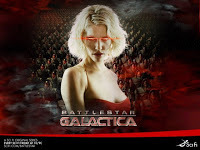 Having just finished watching the Battlestar Galactica series for the second time, I have to say I am just as impressed with the power of the "re-imagined" 2004-2009 series as at my first viewing.
Having just finished watching the Battlestar Galactica series for the second time, I have to say I am just as impressed with the power of the "re-imagined" 2004-2009 series as at my first viewing."After losing the war against the Cylon robots, the Battlestar Galactica crew speed toward the fabled 13th colony, Earth. Galactica Commander Adama and President Laura Roslin face waning supplies, crushed morale, ... and the credible threat Cylons aboard the ship." (IMdb)The above is the short pitch for the TV movie debut for the series. A "complete series" set of DVDs is now available for the 4-year run of the Syfy network show for around a hundred dollars.
My main two reactions after having finished the entire series for the second time--a couple of years after the show finished--are that the producers allowed the dramatic situation to play out realistically, creating very powerful episodes, and also an admiration for the intensity that the actors brought to their characters.
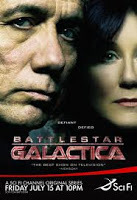 Galactica Commander Adama and President Laura Roslin are two primary roles in the series, played by Edward James Olmos and Mary McDonnell. The roles of steel-hard commander Adama and former kindergarten teacher Roslin (now president of the colonies) played by these two actors are combinations of implacability and vulnerability that truly reveal the human depths of the characters.
Galactica Commander Adama and President Laura Roslin are two primary roles in the series, played by Edward James Olmos and Mary McDonnell. The roles of steel-hard commander Adama and former kindergarten teacher Roslin (now president of the colonies) played by these two actors are combinations of implacability and vulnerability that truly reveal the human depths of the characters.In general, all the characters are seen at their best and their worst. At various times we are amazed, disgusted, disappointed, and inspired. We see individuals questioning their humanity because of the decisions they are forced to make, and we see a new race, the Cylons, whose newly enlivened emotions are rocked and jolted as they watch the roil of emotions of humanity.
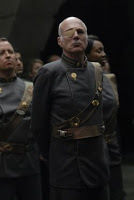 There is a large cast of significant characters, too many to detail, but two demand mention--albeit that I am doing a disservice to those excellent actors whom I am not mentioning.
There is a large cast of significant characters, too many to detail, but two demand mention--albeit that I am doing a disservice to those excellent actors whom I am not mentioning.Michael Hogan portrays Colonel Saul Tigh, a tough-as-nails drunk whose weak spot is his cat-on-a-hot-tin-roof wife Ellen. The eye patch is appropriate; he's a pirate of a character: a staggeringly despicable character who is tragically flawed yet provides unexpected moments of elevated human emotion.
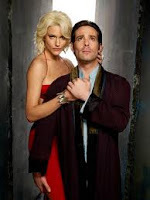 James Callis portrays Dr. Gaius Baltar, a genius who spouts grand concepts but who is always out for ol' number one. Callis's characterization is inspired: comic relief and the source of all evil poured into one character. Baltar is the study of a weak man faced with great danger and great opportunity. He manages to live through all and provides many moments of introspection on the difficulty of making the right decision at the right time.
James Callis portrays Dr. Gaius Baltar, a genius who spouts grand concepts but who is always out for ol' number one. Callis's characterization is inspired: comic relief and the source of all evil poured into one character. Baltar is the study of a weak man faced with great danger and great opportunity. He manages to live through all and provides many moments of introspection on the difficulty of making the right decision at the right time.At times the series is unflinching, and watching the drama unfold is uncomfortable. Perhaps it was the opportunity to watch episodes one after the other that added to the intensity. At least, though, having the DVDs allowed one to skip through and beyond the cliff-hangers.
A final thank you needs to be given to the series, its creators, and the Syfy network for allowing the series of four seasons to end and provide closure. This is not just a TV series that ended by not being "picked up" for another season. Not all will like or admire the ending conceptualization, but it does provide a sense of completeness and meaning to the rocket-jockey ride that the series gives the viewer.
Copyright 2011 by Thomas L. Kepler, all rights reserved
Published on December 20, 2011 03:45
December 17, 2011
How to Run a Goodreads Giveaway: what I learned from running one (Part 1)
 The Stone Dragon just finished its three-week giveaway at Goodreads.
The Stone Dragon just finished its three-week giveaway at Goodreads. Goodreads is a reader/writer online community of over six million people. Sponsoring a book giveaway is a means of promoting a book for very little cost: the cost of the book plus shipping.
Here is information regarding my book giveaway that just finished at Goodreads:
Run-time: 23 days. Entrants: 803.2 books given away166 "to read" designationsThe results for the giveaway were about average--although I could have run the contest for two months rather than three weeks. I wanted to end early enough to send the giveaways out before Christmas, though.
Patrick Brown from Goodreads was interviewed at Novelists Inc. by Vonna Harper: "Goodreads for Writers."
On average, about 750 people enter each giveaway, and of those people, we've found that about 8% of them will add the book to their to-read shelf, win or lose. About 45% of the winners review the book, meaning that the more copies you offer, the more reviews you are likely to get. And reviews are really the fuel that drives everything on Goodreads. When a member reviews your book, not only do their friends see that review, but it often gets pushed to Facebook, Twitter, and their blog, too. We've found that about 1/5 of all Goodreads users write a book blog, and we do our best to make it easy for those users to share their reviews on their blogs.
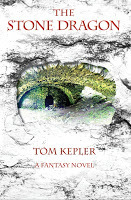 The interview is quite informative, and anyone interested in setting up a Goodreads giveaway should read it. Goodreads' inception and the development of the Author Program are covered in addition to the giveaway promotional opportunity.
The interview is quite informative, and anyone interested in setting up a Goodreads giveaway should read it. Goodreads' inception and the development of the Author Program are covered in addition to the giveaway promotional opportunity.Brown also mentions how to set up a Goodreads giveaway in the interview. Another explanation in a different blog article also describes the steps, at Ebook Formatting Made Simple. By the way, Goodreads is doing beta testing on ebook giveaways and hopes to have a program available sometime in the upcoming year.
What would I do differently with the next Goodreads giveaway?
Run for a longer period of timeGive away more booksCreate a strategy and task timeline prior to starting the giveaway Promote the giveaway more with forums and discussion groupsContact bloggers that I know to also feature the giveaway and use the giveaway widgetContact Facebook and Twitter friends to share the giveaway news--in general, to utilize the social networks I've developedAnyone else who has suggestions, please comment below.
Goodreads is a vast resource, and I'm only now beginning to learn how to use it. It's a great big bunch of readers who love books, a virtual library and book shop: seems like a good place to hang out.
Copyright 2011 by Thomas L. Kepler, all rights reserved
Published on December 17, 2011 07:00
How to Run a Goodreads Giveaway: what I learned from running one
 The Stone Dragon just finished its three-week giveaway at Goodreads.
The Stone Dragon just finished its three-week giveaway at Goodreads. Goodreads is a reader/writer online community of over six million people. Sponsoring a book giveaway is a means of promoting a book for very little cost: the cost of the book plus shipping.
Here is information regarding my book giveaway that just finished at Goodreads:
Run-time: 23 days. Entrants: 803.2 books given away166 "to read" designationsThe results for the giveaway were about average--although I could have run the contest for two months rather than three weeks. I wanted to end early enough to send the giveaways out before Christmas, though.
Patrick Brown from Goodreads was interviewed at Novelists Inc. by Vonna Harper: "Goodreads for Writers."
On average, about 750 people enter each giveaway, and of those people, we've found that about 8% of them will add the book to their to-read shelf, win or lose. About 45% of the winners review the book, meaning that the more copies you offer, the more reviews you are likely to get. And reviews are really the fuel that drives everything on Goodreads. When a member reviews your book, not only do their friends see that review, but it often gets pushed to Facebook, Twitter, and their blog, too. We've found that about 1/5 of all Goodreads users write a book blog, and we do our best to make it easy for those users to share their reviews on their blogs.
 The interview is quite informative, and anyone interested in setting up a Goodreads giveaway should read it. Goodreads' inception and the development of the Author Program are covered in addition to the giveaway promotional opportunity.
The interview is quite informative, and anyone interested in setting up a Goodreads giveaway should read it. Goodreads' inception and the development of the Author Program are covered in addition to the giveaway promotional opportunity.Brown also mentions how to set up a Goodreads giveaway in the interview. Another explanation in a different blog article also describes the steps, at Ebook Formatting Made Simple. By the way, Goodreads is doing beta testing on ebook giveaways and hopes to have a program available sometime in the upcoming year.
What would I do differently with the next Goodreads giveaway?
Run for a longer period of timeGive away more booksCreate a strategy and task timeline prior to starting the giveaway Promote the giveaway more with forums and discussion groupsContact bloggers that I know to also feature the giveaway and use the giveaway widgetContact Facebook and Twitter friends to share the giveaway news--in general, to utilize the social networks I've developedAnyone else who has suggestions, please comment below.
Goodreads is a vast resource, and I'm only now beginning to learn how to use it. It's a great big bunch of readers who love books, a virtual library and book shop: seems like a good place to hang out.
Copyright 2011 by Thomas L. Kepler, all rights reserved
Published on December 17, 2011 07:00
December 15, 2011
I Receive the "Versatile Blogger" Award Twice in One Week!
 Receiving the Virtual Blogger Award is an honor because it is designated by other bloggers. It is a recognition by writers who are actively engaged in the process of sharing by blogging.
Receiving the Virtual Blogger Award is an honor because it is designated by other bloggers. It is a recognition by writers who are actively engaged in the process of sharing by blogging. When I began blogging two years ago, my research said to create focused blogs, but then I realized that I'd have to maintain regular posts for blogs on education, writing, gardening, bicycling, the school where I teach, and the Transcendental Meditation program. I decided just to focus on my interests and let readers decide if they wanted to read a particular post. It was my job to create harmony from the diversity of my life interests.
I guess, judging by this Versatile Blogger Award, that diversity has its positive points, too.
Thank-you to these two bloggers who awarded me the Versatile Blogger Award:
Rosanne Dingli: an Australian writer who writes about her lifetime of experience in writing and publishing. I have reviewed one of her books, Thank the blogger who honored you and be sure to link to his or her blog.Share seven things about yourself.Pass the award on to five deserving bloggers.I've already given my thanks and links to Rosanne and Mary. Of the last two requirements, my favorite will be citing five other worthy bloggers. But on to seven things about myself first:
I am an eclectic reader and will often move from a fantasy/alternative history to a western to a classic and then on to a historical novel, a non-fiction book, or a biography. Good reading is not confined to a single genre.I like to ride my bike to work (1.6 miles), and one of my favorite memories is coming home and having my front coated in ice from freezing rain--at least, it's a favorite memory now that it's over.I started my writing career with poetry and find that poetry has greatly influenced my writing of prose. There is a good article about that from Flash Fiction Chronicles.I tend to write the beginning of a book about ten times--and then I can move on. I think I need to establish for myself the tone and rhythm of the words for that particular piece before I can really move on manifesting the vision.I like to garden, and it was my joy to include a garden gnome as a significant character in my fantasy novel, The Stone Dragon. Also, I think I did a pretty good job of debunking the stereotype of gnomes as little pudgy individuals who wear tall pointy hats.I've been a classroom teacher for thirty-three years--and always with at least one middle school class, one with eight. It's the hardest thing I've ever done, but I've never been bored!I find the saying "The world is as we are" very significant to my writing. Five other bloggers deserving the Versatile Blogger Award . . .
Carol Buchanan, accomplished author and horsewoman Jessica Torres, book reviewer extraordinaireGenevieve Graham, author and editorShawn MacKenzie, author and knower of all about dragonsMichael J. Sullivan, an independent writer who "made it" Thank you to these five writers/bloggers for their example and support.
Copyright 2011 by Thomas L. Kepler, all rights reserved
Published on December 15, 2011 04:40
December 13, 2011
My Zane Grey Writing Chair
We have done some "fall cleaning" and reorganization of our house, and that has included a new "Zane Grey" writing chair for me.
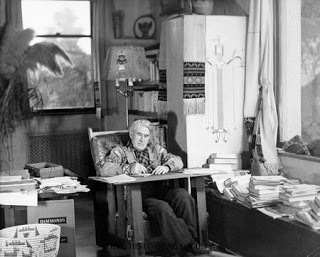 Zane Grey writingAfter we moved the guest bed out of my office room, I told my wife that I'd like a comfortable chair to write in, like Zane Grey had. I suggested buying a lawn chaise lounge and putting a blanket over it. That comment fits with my frugal temperament. My wife later emailed me and asked if it would be okay to spend somewhat more on the chair, sending me some online examples.
Zane Grey writingAfter we moved the guest bed out of my office room, I told my wife that I'd like a comfortable chair to write in, like Zane Grey had. I suggested buying a lawn chaise lounge and putting a blanket over it. That comment fits with my frugal temperament. My wife later emailed me and asked if it would be okay to spend somewhat more on the chair, sending me some online examples.
I suggested that we try a local furniture store where we had bought furniture before and also had had some specialty pieces made: Central Park Home Furnishings and Futon Shop.
We found my "Zane Grey" chair there.

A few years ago, the bookshelf in the background was also purchased through Central Park, who contracted with a local cabinet maker to have the piece made.
Now, of course, I just have to get the time to use it. An early Merry Christmas to me!
Copyright 2011 by Thomas L. Kepler, all rights reserved
 Zane Grey writingAfter we moved the guest bed out of my office room, I told my wife that I'd like a comfortable chair to write in, like Zane Grey had. I suggested buying a lawn chaise lounge and putting a blanket over it. That comment fits with my frugal temperament. My wife later emailed me and asked if it would be okay to spend somewhat more on the chair, sending me some online examples.
Zane Grey writingAfter we moved the guest bed out of my office room, I told my wife that I'd like a comfortable chair to write in, like Zane Grey had. I suggested buying a lawn chaise lounge and putting a blanket over it. That comment fits with my frugal temperament. My wife later emailed me and asked if it would be okay to spend somewhat more on the chair, sending me some online examples.I suggested that we try a local furniture store where we had bought furniture before and also had had some specialty pieces made: Central Park Home Furnishings and Futon Shop.
We found my "Zane Grey" chair there.

A few years ago, the bookshelf in the background was also purchased through Central Park, who contracted with a local cabinet maker to have the piece made.
Now, of course, I just have to get the time to use it. An early Merry Christmas to me!
Copyright 2011 by Thomas L. Kepler, all rights reserved
Published on December 13, 2011 04:02
December 10, 2011
Consciousness-based Writing: Progressive and Evolutionary
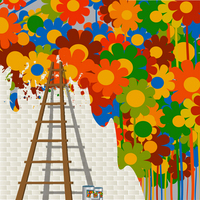 Progressive and Evolutionary are two of the 50 Qualities of the Unified Field.
Progressive and Evolutionary are two of the 50 Qualities of the Unified Field. Taught in pairs, these qualities are one means at Maharishi School for teaching Consciousness-Based education, one means for connecting the student and the subject matter. By practicing the Transcendental Meditation technique, the "lab" in which they experience their own inner selves, students then learn their traditional subjects but also learn to see them as expressions of consciousness, forming a more personal link with their studies.
How do these two qualities relate to consciousness-based writing? How do I find these qualities to connect to my writing?
Here are the etymologies of progressive and evolutionary, thanks to the free Merriam-Webster online dictionary (note: I don't have access to my unabridged Merriam-Webster dictionary right now, or I'd use that--it's a wonderful book):
Progress: Middle English, from Anglo-French progrés, from Latin progressus advance, from progredi to go forth, from pro- forward + gradi to go — more at pro-, grade. First Known Use: 15th century. The definition of progressive includes consideration of time in many aspects of life--education, politics, government, politics. The word includes not just the act of adding more but also the consideration of what existed previously and what is needed in the future.Evolve: Latin evolvere to unroll, from e- + volvere to roll — more at voluble. First Known Use: 1775. The definition of evolutionary includes the idea of something unfolding, of a process changing in a certain direction from lower to higher.When writing, it is important to go forward, to progress from a blank piece of paper (or computer screen) to the first-time-through sloppy copy. This can also be considered as letting the idea unroll, to allow the vision to be connected to the words.
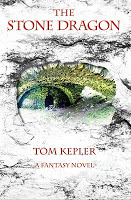 For my novel The Stone Dragon, the process was truly a synthesis of my years of experience, both inner and outer. I wanted to write a story that expressed how we create our own reality, of how our outer world comes to be furbished with the accoutrements of our inner life. I wanted to write a good story--one that was not only engaging but which also led the reader to a good place.
For my novel The Stone Dragon, the process was truly a synthesis of my years of experience, both inner and outer. I wanted to write a story that expressed how we create our own reality, of how our outer world comes to be furbished with the accoutrements of our inner life. I wanted to write a good story--one that was not only engaging but which also led the reader to a good place.Whether or not I actually did that will, of course, ultimately be judged by time and the reader. I think the process of writing the book was good for me, though. I grew in the process; writing the book was an progressive and evolutionary experience. But what does that mean?
Writing is consciousness-based and progressive and evolutionary when the words lead both the writer and the reader to a more powerful, higher or heightened awareness of one's inner self and of the nature of existence.
These are big words and concepts. I don't think a writer gets up in the morning and says, "I think I'll write today about the more powerful, higher or heightened awareness of one's inner self and of the nature of existence."
I sure don't anyway. But I think if we look to the classics, we can see that the writer has taken a journey and that the writer includes the reader on that journey. It doesn't have to be a "classic," either. A note--why not a grocery list?--could in some way be phrased with a purity of intent and word choice to some minute progressive and evolutionary effect upon the writer and reader.
It all starts with the knower, the writer, the artist, the open and honest, progressive and evolutionary human mind. Maharishi Mahesh Yogi, who established the Transcendental Meditation and Consciousness-Based education programs, said that the outer expressions of the artist are reflections of the artist's inner being. I agree with that.
I'm glad I practice the Transcendental Meditation technique so that I can begin my writing day, as best I can, with a tabula rasa, a clean slate, unmarred (to whatever extent) by stresses, strains, and fatigue. I like it when an idea comes to me alone and uncluttered by a rabble and chaos of other unruly ideas. This is not to say an ocean of ideas is not good, but let me be strong enough to brave the tide. Let me ride the wave.
Writing the deluge of creativity from that place of silence doesn't always happen, but when it does, I write those words down and cherish the process.
Copyright 2011 by Thomas L. Kepler, all rights reserved
Published on December 10, 2011 07:30
December 8, 2011
Young George Harrison: a delanceyplace re-post

In today's excerpt - the relentless Nazi bombing of Liverpool left it scarred and resource starved. Out of this deprivation, its citizens - including young George Harrison and his friends - developed a sense of humor, a work ethic, and the hope of escape:
"There was an honesty that we had, a very simple, naive honesty, and I think that had a lot to do with where we came from. The people up there have a certain naive honesty and humour. They say you have to have humour to live in a place like that. Everybody who comes out of Liverpool thinks they are comedians, and we were no exception. That kept us going." GEORGE HARRISON
"During the war, Liverpool was the second biggest port in the empire, after London, with huge docks. It really did get hammered in the Blitz. You hear the story about Aunt Mimi dodging the bombs, going to the hospital when John [Lennon] was born. That's not an exaggeration. Liverpool got the shit bombed out of it. Post-war, our playgrounds were bombsites, which could be pretty dangerous. You got streets that just went off into nothing. We were very aware of the war. Near where George, Paul and I went to school at the Liverpool Institute, there was a church called St Luke's that had been firebombed. The whole church was just a burned-out shell. It's still there now as a reminder. There would always be a few kids who didn't have a father. It was never talked about, but you didn't know whether they were children of an American soldier or whether their father had died in the war." NEIL ASPINALL, Lifelong friend, CEO Apple Corps ...
"I always remember my Mum saying that they had been on the housing list to have another house for twenty-two years. In 1949 they eventually did get a house, and we moved to Speke in about 1950. Speke was a building site basically; there were no roads or anything. It was like two feet of mud everywhere. But it was a bigger house." PETER HARRISON, Brother
"There were numerous parks around Liverpool. People always think that Liverpool's a big built-up city, but if you could see it from the air I think you'd realise there are more parks there than in the majority of cities. When you were a little one you played on the bombsites but by and large weekends as a family we always used to go to a park somewhere - take some sandwiches and a bottle of water." HARRY HARRISON, Brother
"I used to live in a place called Speke, which is on the outskirts of Liverpool. My mother was a midwife, so she would keep getting moved to the outskirts. The roads were kind of unmade when we got there. It was frontier land. And George lived just down the road. It was a bus stop away. It was a road called Central Avenue, which was the main road, and then there was Western Avenue, and then half an hour away was the city, where our school was. And we both went to the same school. I would get on the bus, and then a stop later George would get on. So I'd see this kid with a quiff, but younger than me, so I wouldn't pay much attention, because I was cooler, I was older. But eventually he must have had a seat next to me on the bus, so that's how we met. Obviously going to the same school we had a bond. And then it turned out that we both loved rock 'n' roll, and guitars. He was a cocky little guy. He had a good sense of himself; he wasn't cowed by anything. He had a great haircut.
"Looking back now, it was pre-fame - we were just ordinary kids who couldn't get in places because we weren't famous. Teachers didn't like us. Rock 'n' roll hadn't properly arrived yet. I always think of it as kind of Dickensian. And the school that I went to with George, incidentally, was a very Dickensian old place. In fact, Dickens had talked there. That's how Dickensian it was. You grew up wanting to go somewhere else. It made you hungry, so art was a great golden vision. For us, we wouldn't have called it art, but rock 'n' roll." PAUL McCARTNEY
Author: Olivia Harrison Title: George Harrison Publisher: Abrams Date: Copyright 2011 by Harrisongs, Ltd. Pages: 15-32
George Harrison: Living in the Material World by Olivia Harrison by AbramsHardcover ~ Release Date: 2011-09-27If you wish to read further: Buy Now
Should you use the above link to purchase a book, delanceyplace proceeds from your purchase will benefit a children's literacy project. All Delanceyplace profits are donated to charity.
About Us
Delanceyplace is a brief daily email with an excerpt or quote we view as interesting or noteworthy, offered with commentary to provide context. There is no theme, except that most excerpts will come from a non-fiction work, mainly works of history, are occasionally controversial, and we hope will have a more universal relevance than simply the subject of the book from which they came.
To visit our homepage or sign up for our daily email click here
To view previous daily emails click here.
To sign up for our daily email click here.
Published on December 08, 2011 05:00
December 6, 2011
Goodreads Book Giveaway of The Stone Dragon
A Christmas gift and promotion to the readers of fantasy, I have joined the Goodreads Book Giveaway program for my novel The Stone Dragon. I purposely ended the giveaway early enough so that if Goodreads sends me the mailing addresses of the winners quickly, I can mail the books so that they reach the winners by Christmas. Good luck!
.goodreadsGiveawayWidget { color: #555; font-family: georgia, serif; font-weight: normal; text-align: left; font-size: 14px; font-style: normal; background: white; } .goodreadsGiveawayWidget img { padding: 0 !important; margin: 0 !important; } .goodreadsGiveawayWidget a { padding: 0 !important; margin: 0; color: #660; text-decoration: none; } .goodreadsGiveawayWidget a:visted { color: #660; text-decoration: none; } .goodreadsGiveawayWidget a:hover { color: #660; text-decoration: underline !important; } .goodreadsGiveawayWidget p { margin: 0 0 .5em !important; padding: 0; } .goodreadsGiveawayWidgetEnterLink { display: block; width: 150px; margin: 10px auto 0 !important; padding: 0px 5px !important; text-align: center; line-height: 1.8em; color: #222; font-size: 14px; font-weight: bold; border: 1px solid #6A6454; -moz-border-radius: 5px; -webkit-border-radius: 5px; font-family:arial,verdana,helvetica,sans-serif; background-image:url(http://goodreads.com/images/layout/gr... background-repeat: repeat-x; background-color:#BBB596; outline: 0; white-space: nowrap; } .goodreadsGiveawayWidgetEnterLink:hover { background-image:url(http://goodreads.com/images/layout/gr... color: black; text-decoration: none; cursor: pointer; }
Goodreads Book Giveaway
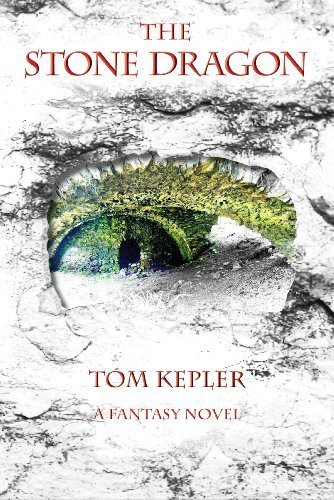
The Stone Dragon
by Tom Kepler
Giveaway ends December 16, 2011.
See the giveaway details
at Goodreads.
Enter to win

.goodreadsGiveawayWidget { color: #555; font-family: georgia, serif; font-weight: normal; text-align: left; font-size: 14px; font-style: normal; background: white; } .goodreadsGiveawayWidget img { padding: 0 !important; margin: 0 !important; } .goodreadsGiveawayWidget a { padding: 0 !important; margin: 0; color: #660; text-decoration: none; } .goodreadsGiveawayWidget a:visted { color: #660; text-decoration: none; } .goodreadsGiveawayWidget a:hover { color: #660; text-decoration: underline !important; } .goodreadsGiveawayWidget p { margin: 0 0 .5em !important; padding: 0; } .goodreadsGiveawayWidgetEnterLink { display: block; width: 150px; margin: 10px auto 0 !important; padding: 0px 5px !important; text-align: center; line-height: 1.8em; color: #222; font-size: 14px; font-weight: bold; border: 1px solid #6A6454; -moz-border-radius: 5px; -webkit-border-radius: 5px; font-family:arial,verdana,helvetica,sans-serif; background-image:url(http://goodreads.com/images/layout/gr... background-repeat: repeat-x; background-color:#BBB596; outline: 0; white-space: nowrap; } .goodreadsGiveawayWidgetEnterLink:hover { background-image:url(http://goodreads.com/images/layout/gr... color: black; text-decoration: none; cursor: pointer; }
Goodreads Book Giveaway

The Stone Dragon
by Tom Kepler
Giveaway ends December 16, 2011.
See the giveaway details
at Goodreads.
Enter to win
Published on December 06, 2011 05:00
December 1, 2011
A Writer's Appreciation of Maharishi School and Consciousness-Based Education
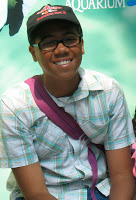 I would like my writing to be appreciated for its deepest value.
I would like my writing to be appreciated for its deepest value.In order for that to be possible, readers have to respond to writing from deep within themselves. I have to elicit that response; the readers have to have the lively ability to contact their deeper selves.
I am pleased that the reviews of my fantasy novel, The Stone Dragon, seem to reflect that nurturing interaction between writer and reader.
The story is constantly referring back to consciousness. How it affects us, how everything is all connected through it, and how it is our birthright to contact our inner silence through consciousness.One especial review, the first review for the book, was written by a former student. Sebastien is a tenth grader, going to school in Florida, the last I heard. I had him as a student at Maharishi School when he was in the 7th grade but then moved away.
Here is what Sebastien said in our recent correspondence about his experience at Maharishi School:
Maharishi School was a unique, refreshing experience. For once I felt that education taught me how to LIVE and not just how to get a job. It expanded my understanding of consciousness and especially myself. I knew myself better when I was meditating at Maharishi School than any other place. Essentially, TM taught me who I am.I was very happy when I heard that Sebastien had seen that my novel was available for online purchase and that he had bought the Kindle edition for his iPad. He wrote me a note, saying that he had bought it and that he would review it when finished. After three years of not hearing from him, it was a wonderful, unexpected connection.
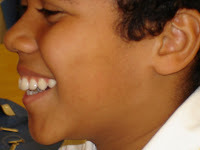 I was curious as to what Sebastien would write. He had been a student at Maharishi School, engaged in the school's Consciousness-Based approach to education, and had practiced the Transcendental Meditation technique daily.
I was curious as to what Sebastien would write. He had been a student at Maharishi School, engaged in the school's Consciousness-Based approach to education, and had practiced the Transcendental Meditation technique daily.However, three years later, how would he react to a "consciousness-based" novel? How had he fared in the wide world?
Below is his Amazon review:
A story of magic, consciousness, love, and confronting fears
For a story that starts out in a garden, it goes a long way from home. Just as a warning, this review will contain a few spoilers. At first glance The Stone Dragon seems like just a fantasy novel, but in reality it is so much more. Glimmer (the main character) starts out in the garden of the stone house owned by his master, Alma-Ata. Glimmer, or, Not-A-Glimmer-Of-Magic as he is sometimes referred to as, is frustrated. His master is a Mage who teaches him nothing because he shows no magical talent himself. In time, Glimmer learns of the true magic his master possesses and the powerful magic that lies dormant within himself as well. Without spoiling too much I will say that Kepler crafts a world of magic and fantasy that has aspects from traditional fantasy, while still keeping it original and fresh.I would say, "Excellent job, Sebastien."
The story is constantly referring back to consciousness. How it affects us, how everything is all connected through it, and how it is our birthright to contact our inner silence through consciousness. There is an underlying theme of consciousness throughout the book and while Glimmer is on his many adventures. The ending of the story is fantastic and certainly doesn't disappoint. It seems so appropriate after seeing everything that has happened and how everything has winded down. One of the best books I've read and I'm certainly looking forward to the sequel and the short story coming out. Excellent job, Kepler.
I am teaching Sebastien's classmates this year in American Literature. We would all like to have him in the class with us. I am happy, though, to see that Sebastien is able to value the role of consciousness in his life. And I'm happy to see that he's still reading. After all, I was his English teacher!
Copyright 2011 by Thomas L. Kepler, all rights reserved
Published on December 01, 2011 04:00
November 29, 2011
The Gift of Enjoying the Moment
 Sunday afternoon, I decided to lie down for a bit and rest.
Sunday afternoon, I decided to lie down for a bit and rest.As I drifted in and out of sleep, at one moment I had the thought: "I can lie here as long as I want. I don't have to plan anything, do anything, evaluate anything to provide a foundation for future action. I can just enjoy this restful moment. I'm not even required to think a thought."
Of course, those were thoughts, but between them were moments of simple, easy restfulness, of just being, easy in my skin and happy in my heart.
We all have goals. I think, though, that we are fortunate if our goals are how to enjoy our happiness or how to help others enjoy life more. We are fortunate if we are happy and are not desperately seeking happiness. I cherish those moments of unattributed happiness, one might say, moments I'm just happy without attribution to a particular person, object, or event. Just happy.
We might say this is the real basis of action--acting from fullness, from full potentiality.
I had to paint a wall of my house the other day, and painting that wall was a joy. Tape it off, cut in the borders, and roll the wall--simple, concrete, and with immediate satisfaction. And I wasn't spending the time worrying about tomorrow or something else. Just enjoying the moment.
The pure distillation of these moments of ease and happiness are those moments during Transcendental Meditation when the mind, like a wave in the ocean, settles down to silence.
Our lives are a string of moments linked with the infinite thread of silent being. Each bead, each pearl, is a thing of beauty, but it is the thread that makes the necklace.
Copyright 2011 by Thomas L. Kepler, all rights reserved
Published on November 29, 2011 03:46



